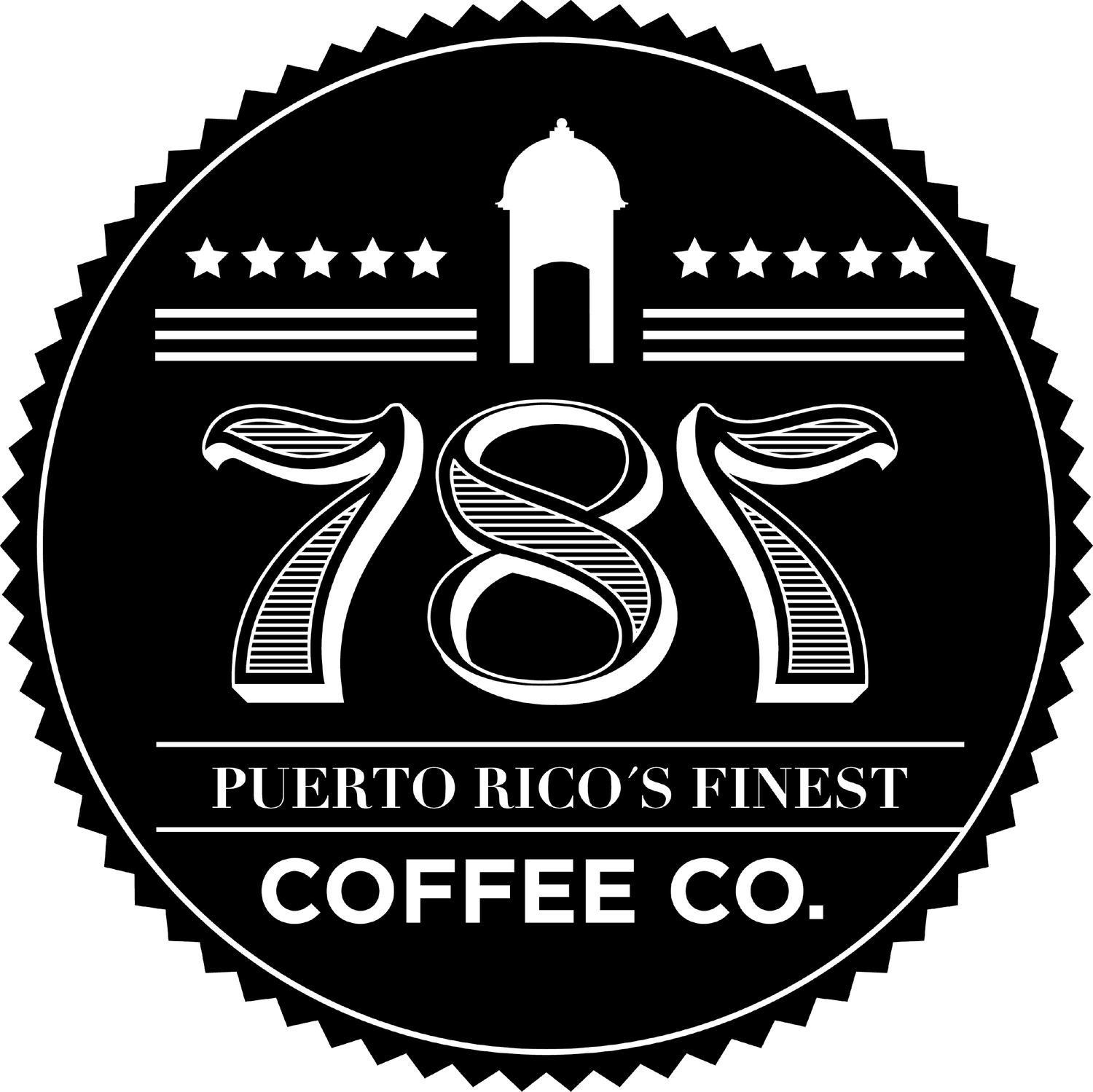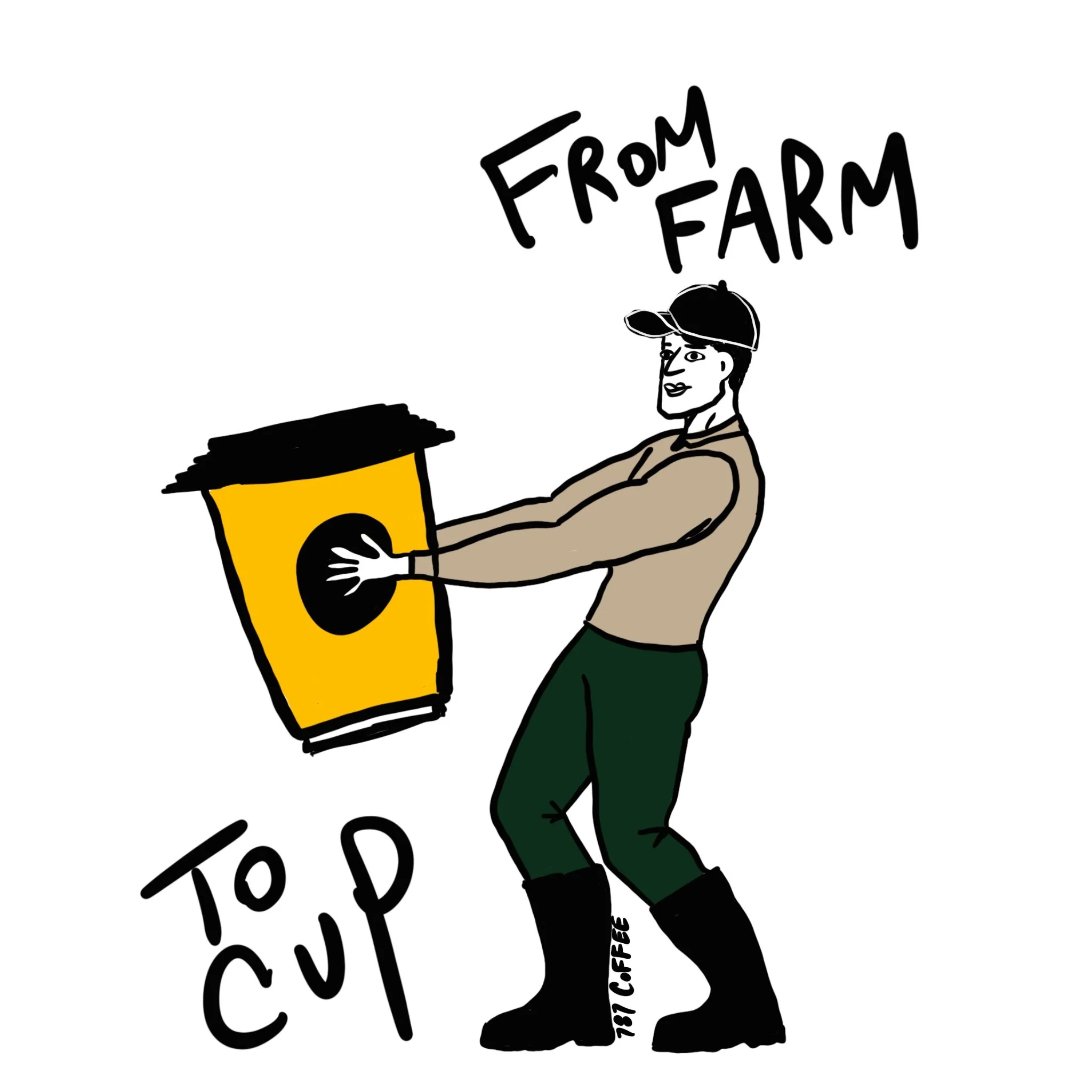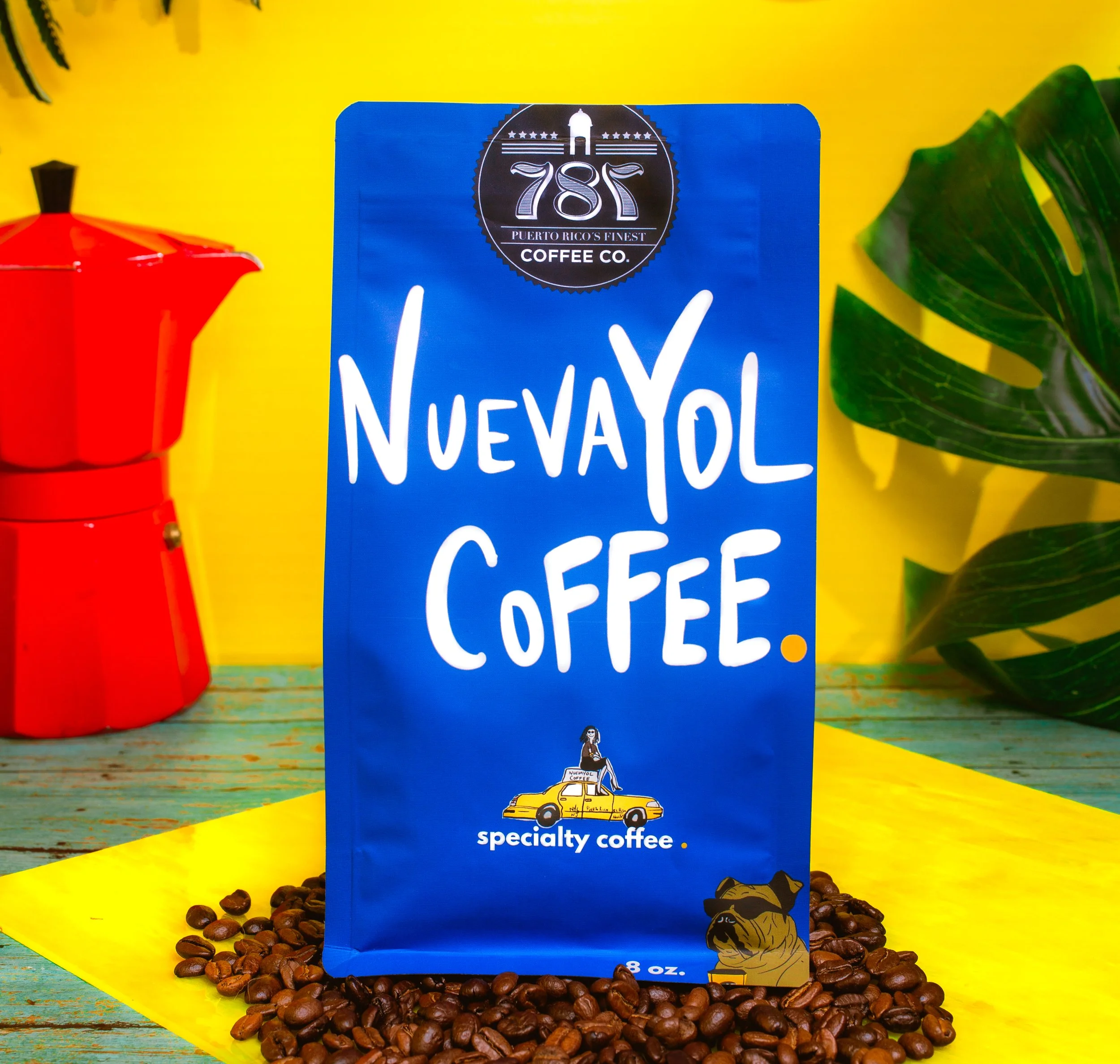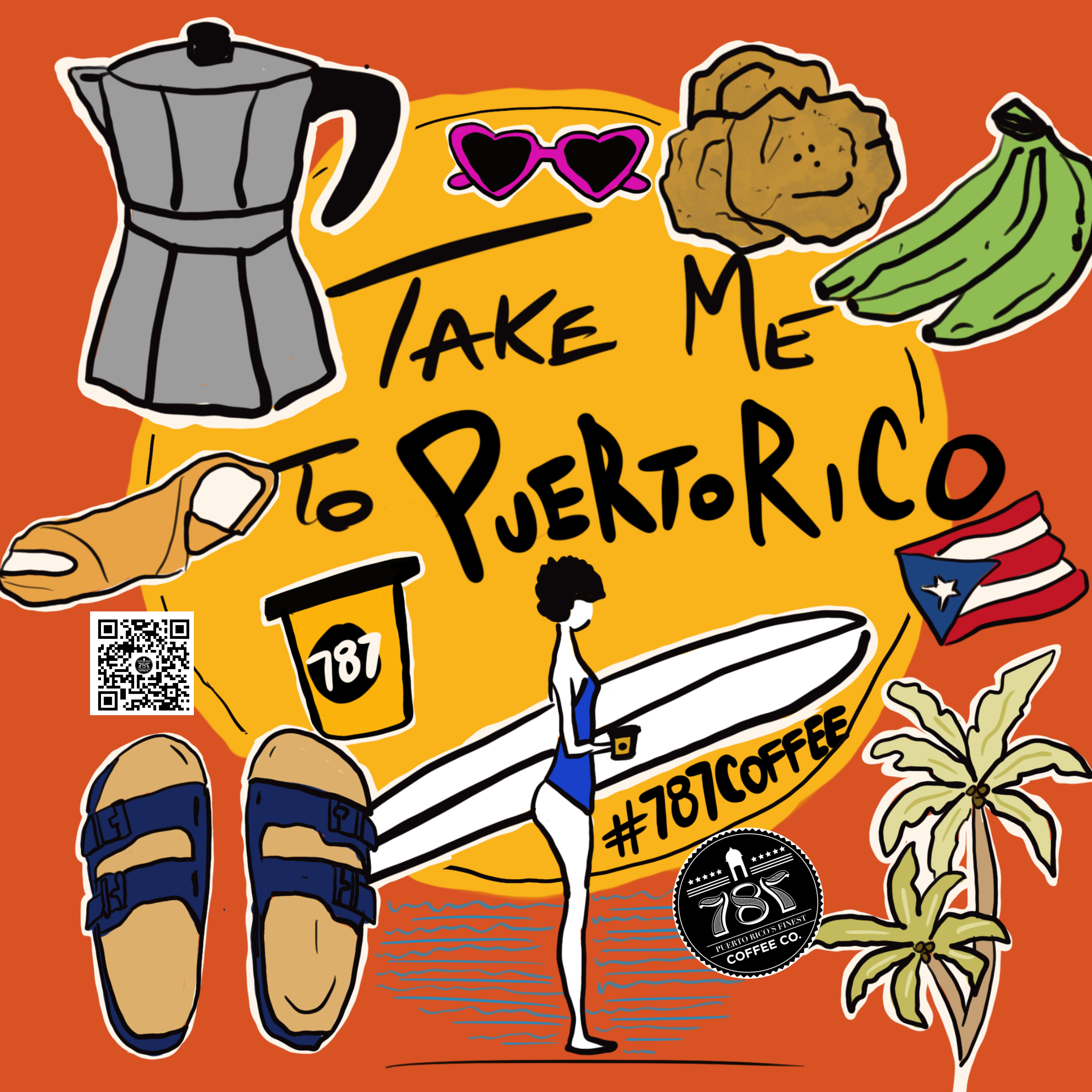What 'From Farm to Cup' Actually Means: The 787 Coffee Difference
Let’s Connect on Social
Hello Caffeinated Humans!
You've probably seen it everywhere:
"Farm-to-table." "Farm-to-cup." "Direct trade." "Single-origin."
Every coffee shop uses these terms. They're on bags, menus, and Instagram posts.
But what do they actually mean?
More importantly: Are they just marketing buzzwords, or do they actually matter?
Here's the truth: Most coffee shops that say "farm-to-cup" don't actually own a farm.
They buy beans from importers who buy from exporters who buy from middlemen who buy from farmers. By the time the coffee reaches your cup, it's passed through 5+ hands—and nobody really knows its story.
At 787 Coffee, it's different.
We don't just buy coffee from a farm. We OWN the farm. We grow the coffee. We process it. We roast it. We serve it.
That's real farm-to-cup.
Today, we're breaking down what farm-to-cup actually means, why most coffee ISN'T farm-to-cup (even when they claim it), and why it matters for YOU.
Let's do this!
What "Farm-to-Cup" Actually Means
Farm-to-cup means coffee is grown, processed, roasted, and served by the same company—with no middlemen.
The complete chain looks like this:
Growing - Coffee trees are planted, maintained, and harvested
Processing - Coffee cherries are de-pulped, fermented, dried, and milled
Roasting - Green beans are roasted to bring out flavor
Brewing - Coffee is prepared and served to customers
True farm-to-cup = ONE company controls ALL of these steps.
Why is this rare?
Because it's HARD. You need:
Land and a farm (expensive)
Agricultural knowledge (takes years)
Processing equipment (costly)
Roasting expertise (skill + equipment)
Coffee shops or distribution (infrastructure)
Most coffee companies do ONE of these things well—not all of them.
That's why true farm-to-cup coffee is so rare.
How MOST Coffee Gets to Your Cup (Spoiler: It's Not Farm-to-Cup)
Let's break down the typical coffee supply chain.
The Traditional Coffee Supply Chain:
Step 1: Farmer grows and harvests coffee
Usually small farm, limited resources
Sells to local buyer for cash
Step 2: Local buyer aggregates coffee from multiple farms
Mixes coffee from different farms
Sells to exporter
Step 3: Exporter processes and ships coffee
De-pulps, dries, mills beans
Ships green beans overseas
Step 4: Importer receives and warehouses coffee
Coffee sits in warehouse (sometimes for months)
Sells to roasters
Step 5: Roaster buys, roasts, and packages coffee
Roasts beans in large batches
Sells to distributors or directly to cafes
Step 6: Coffee shop buys roasted coffee
Orders from distributor or roaster
Brews and serves to customers
Total steps: 6+
Total middlemen: 4-5
Time from harvest to cup: 6-18 months
Traceability: Almost none
Result: You have no idea where your coffee actually came from, how fresh it is, or who grew it.
The "Direct Trade" Coffee Supply Chain:
Some coffee shops skip a few middlemen and buy "direct trade."
Step 1: Farmer grows and harvests
Step 2: Roaster buys directly from farmer (skips exporter/importer)
Step 3: Roaster processes, roasts, packages
Step 4: Coffee shop buys from roaster
Step 5: You drink it
Total steps: 5
Total middlemen: 2
Time from harvest to cup: 3-12 months
Traceability: Better, but still limited
Result: Better than traditional, but still not farm-to-cup. The roaster doesn't own the farm or control growing/harvesting.
The 787 Coffee Supply Chain (REAL Farm-to-Cup)
Now let's look at how 787 Coffee does it.
Our Supply Chain:
Step 1: We grow coffee at Hacienda Iluminada (our farm in Maricao, Puerto Rico)
We own the land
We employ the farmers
We control quality from day one
Step 2: We process the coffee at our farm
Hand-picked cherries
De-pulped, fermented, dried on-site
We control every processing decision
Step 3: We roast the coffee (in-house roasting)
Small-batch roasting multiple times per week
We decide the roast profile based on the beans
Step 4: We serve it at our coffee shops OR we ship it to you
Fresh from roasting (days, not months)
You drink it
Total steps: 4
Total middlemen: ZERO
Time from harvest to cup: Days to weeks
Traceability: Complete (we know EXACTLY where every bean came from)
Result: You're drinking coffee from trees we planted, picked by farmers we employ, processed on our farm, roasted by our team, and served in our shops.
THAT is farm-to-cup.
Why Farm-to-Cup Matters (It's Not Just Marketing)
Okay, so 787 Coffee controls the entire supply chain. Why does that matter to YOU?
1. Freshness (You Can Taste It)
Traditional coffee: Harvested months ago, sat in warehouses, roasted weeks ago
787 Coffee: Harvested recently, processed immediately, roasted THIS WEEK
Why it matters: Fresh coffee tastes sweeter, more complex, less bitter. Stale coffee tastes flat and lifeless.
You can taste the difference.
2. Quality Control (Every Step)
Traditional coffee: Multiple companies involved = inconsistent quality
787 Coffee: We control EVERYTHING = consistent quality
Why it matters:
We decide when to harvest (only the ripest cherries)
We decide how to process (washed, natural, honey)
We decide how to roast (bringing out the best flavors)
No corners cut. No compromises.
3. Traceability (You Know Your Coffee's Story)
Traditional coffee: "Sourced from [random country]"
787 Coffee: "Grown at Hacienda Iluminada, 3,000 feet elevation, volcanic soil, hand-picked by our farmers"
Why it matters: You know EXACTLY where your coffee came from. You can even visit the farm and see it for yourself.
Transparency = trust.
4. Fair Pay for Farmers (Because We ARE the Farmers)
Traditional coffee: Farmers get 10-20% of the retail price
787 Coffee: We employ the farmers directly = they get fair wages, benefits, and job security
Why it matters: When you buy 787 Coffee, you're directly supporting Puerto Rican farmers and their families.
No middlemen taking cuts.
5. Sustainability (Long-Term Thinking)
Traditional coffee: Short-term profit focus, environmental damage
787 Coffee: We own the land = we protect it for future generations
Why it matters:
Shade-grown coffee (protects biodiversity)
No harmful pesticides
Water conservation
Soil health prioritized
What's good for the earth is good for you.
Be a CAFFEINATED HUMAN.
Be a creative human. Be a good human.
Be a NuevaYOL Caffeinated Human.
6. Flavor (Unique Terroir)
Traditional coffee: Blends from multiple farms = generic flavor
787 Coffee: Single-origin from ONE farm = unique terroir
Why it matters: Our volcanic soil, high elevation, and tropical climate create flavors you can't get anywhere else.
Notes: Dark chocolate, caramel, citrus, brown sugar
You're tasting Puerto Rico in every sip.
Common Myths About Farm-to-Cup Coffee
Let's clear up some misconceptions.
Myth #1: "All specialty coffee is farm-to-cup."
False.
Most specialty coffee shops buy from roasters who buy from importers. It's higher quality than Folgers, but it's NOT farm-to-cup.
Myth #2: "Direct trade is the same as farm-to-cup."
False.
Direct trade skips middlemen but the roaster still doesn't OWN the farm. Farm-to-cup means ONE company owns and operates the entire chain.
Myth #3: "Single-origin means farm-to-cup."
False.
Single-origin means coffee from ONE country or region. But it doesn't mean the coffee shop owns the farm.
787 Coffee is BOTH: Single-origin (from Puerto Rico) AND farm-to-cup (we own everything).
Myth #4: "Farm-to-cup is just a marketing gimmick."
False.
For MOST companies, yes—it's marketing. For 787 Coffee? It's our entire business model.
Come visit Hacienda Iluminada and see for yourself.
What Happens at Hacienda Iluminada (Our Farm)
Let's take you behind the scenes.
Location: Maricao, Puerto Rico
Elevation: 3,000 feet above sea level
Climate: Cool mountain air, tropical rainfall
Soil: Volcanic (nutrient-rich, perfect for coffee)
Size: Expanding continuously
The Coffee Trees
We grow Arabica coffee—the high-quality species known for complex flavors.
Our trees are:
Shade-grown (protected by forest canopy)
Hand-maintained (pruned, weeded, cared for)
Organic (no harmful chemicals)
It takes 3-4 years for a coffee tree to produce its first harvest.
Harvesting (Hand-Picked Only)
When coffee cherries ripen (they turn deep red), our farmers hand-pick them.
Why hand-picked?
Only ripe cherries are selected
Unripe and overripe cherries are left behind
Results in higher quality
Machine harvesting (used by industrial farms) strips entire branches—ripe, unripe, and everything in between. That's why mass-produced coffee tastes inconsistent.
We only pick the best.
Processing (On-Site)
After picking, cherries are processed immediately:
De-pulping - Fruit is removed, leaving the bean
Fermentation - Beans sit in tanks to develop flavor
Washing - Beans are cleaned
Drying - Beans dry in the sun on raised beds
Milling - Outer parchment layer is removed
We experiment with different processing methods:
Washed - Clean, bright, crisp
Natural - Fruity, bold, sweet
Honey - Balanced, complex
This is where flavor is created.
Roasting (Small-Batch Perfection)
Green beans are shipped to our roasting facility where we roast multiple times per week.
Why small-batch?
Maximum freshness
Precise control
Each batch is perfect
We taste-test every roast to ensure it meets our standards.
Shipping or Serving
From there, coffee goes to:
Our coffee shops (NYC, El Paso, Houston, Westfield, Puerto Rico)
Your door (online orders ship within days of roasting)
Farm to cup in DAYS—not months.
How to Tell If Coffee Is REALLY Farm-to-Cup
Not sure if a coffee shop is telling the truth about farm-to-cup? Here's how to tell.
Questions to Ask:
"Do you own the farm where this coffee is grown?"
Real answer: "Yes, we own [farm name] in [location]."
Fake answer: "We work with farms in [vague region]."
"Can I visit your farm?"
Real answer: "Yes! Here's how to book a tour."
Fake answer: Crickets.
"When was this coffee roasted?"
Real answer: "This week" or specific date on bag
Fake answer: No roast date or "recently"
"Who processes your coffee?"
Real answer: "We do, at our farm."
Fake answer: "It's processed at origin" (vague)
At 787 Coffee:
✅ We own Hacienda Iluminada in Maricao, Puerto Rico
✅ You can visit and tour the farm
✅ Every bag has a roast date (this week!)
✅ We process everything on-site
That's real farm-to-cup.
Why Most Coffee Shops Can't Do Farm-to-Cup
Farm-to-cup isn't common because it's HARD.
It Requires:
1. Capital - Buying farmland is expensive 2. Expertise - Growing coffee takes years to learn 3. Infrastructure - Processing equipment, roasting facility, distribution 4. Risk - Weather, pests, crop failure 5. Time - Coffee trees take 3-4 years to produce
Most coffee shops:
Started as cafes (not farms)
Don't have agricultural knowledge
Can't afford the upfront investment
Don't want the risk
So they buy from importers/roasters and call it "specialty."
Nothing wrong with that—but it's not farm-to-cup.
The 787 Coffee Commitment
We didn't start as a coffee shop and buy a farm later.
We started with the farm.
In 2014, Brandon and Sam bought Hacienda Iluminada to:
Revive Puerto Rican coffee
Support the Maricao community
Control quality from seed to cup
Coffee shops came second.
That's why we're different. The farm is our foundation.
Every decision we make starts with: "What's best for the farm, the farmers, and the coffee?"
Not: "What makes the most profit?"
That's the 787 Coffee difference.
How to Experience Farm-to-Cup Coffee
Ready to taste the difference?
Option 1: Order Online
Get fresh, farm-to-cup coffee delivered to your door.
Best Sellers:
Puerto Rican Single-Origin - 100% from Hacienda Iluminada
NuevaYol Blend - Puerto Rico + Mexico + Colombia
Coffee Subscription - Fresh beans delivered monthly
Roasted THIS WEEK. Shipped to you.
Option 2: Visit a Coffee Shop
Experience farm-to-cup in person at our locations:
New York City (multiple locations)
El Paso, Texas
Houston, Texas (coming soon!)
Westfield, New Jersey
Puerto Rico
Option 3: Visit the Farm
Want to see farm-to-cup in action?
Book a tour at Hacienda Iluminada:
Walk through coffee fields
Meet the farmers
See processing in action
Taste coffee steps from where it was grown
Stay in our lodges
Visit our zoo
This is the ultimate coffee experience.
Why Farm-to-Cup is the Future of Coffee
The coffee industry is changing.
Consumers want:
✅ Transparency (know where their coffee comes from)
✅ Quality (fresh, flavorful, specialty-grade)
✅ Ethics (fair pay for farmers)
✅ Sustainability (environmentally responsible)
Farm-to-cup delivers ALL of this.
787 Coffee is leading the way.
We're proving that:
You CAN own a farm and run coffee shops
Quality and sustainability go hand-in-hand
Customers care about the story behind their coffee
Farm-to-cup is the future
Join us.
Ready to Taste Real Farm-to-Cup Coffee?
☕ Shop Fresh Puerto Rican Coffee
☕ Start a Coffee Subscription
☕ Visit a Coffee Shop
🌱 Tour Hacienda Iluminada Farm
From our farm in Maricao, Puerto Rico to your cup—this is real farm-to-cup.
Stay cool and caffeinated,
The 787 Coffee Family
Learn More
📖 Read Our Hurricane Maria Story
📖 How to Brew Coffee at Home
📖 Coffee Gift Guide
👕 Shop Puerto Rican Pride Merch
Be a caffeinated human. Support real farm-to-cup coffee.










